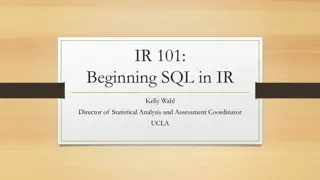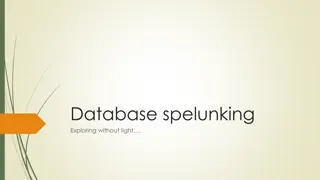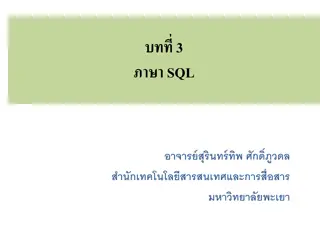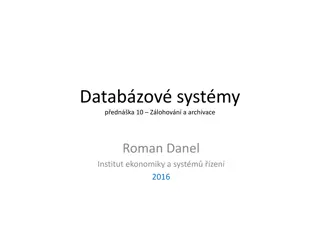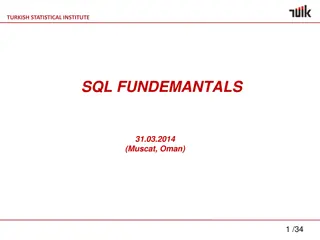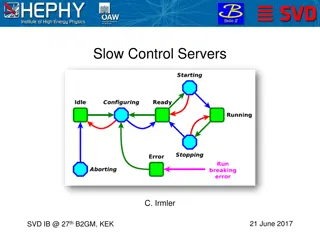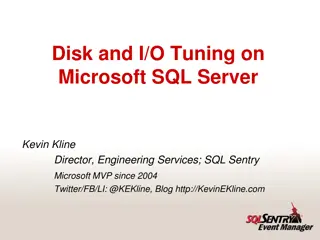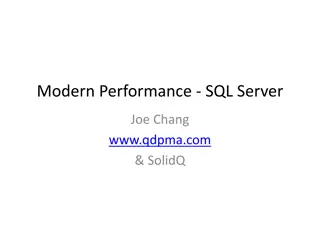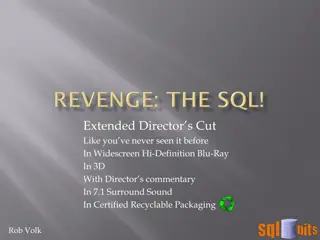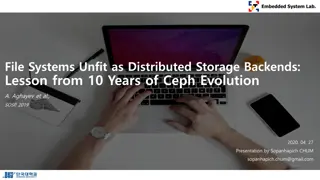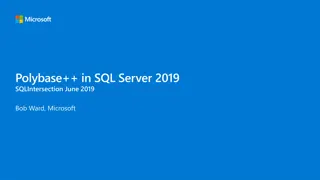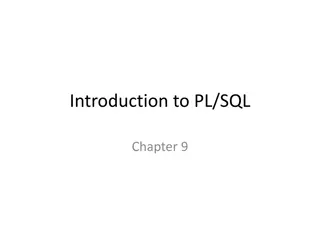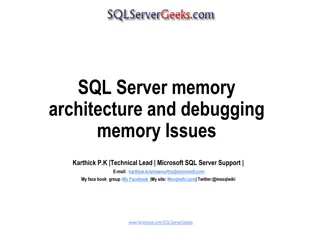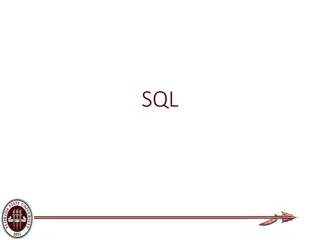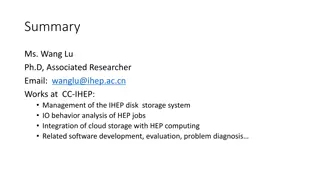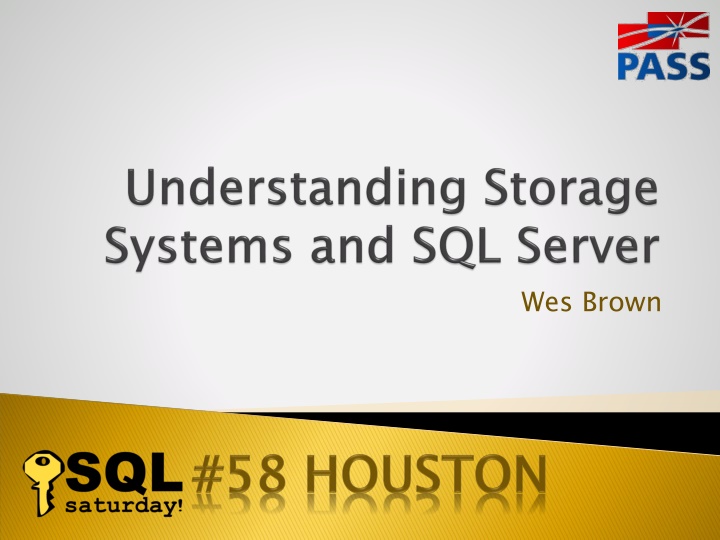
Understanding Server Buses, RAID Configurations, and Disk Drives
Dive into the intricacies of server I/O DNA, covering base system setup, RAID arrays, SQL Servers, file systems, disk controllers, bus types, drive caching, and maximum speeds of various bus types. Learn about the modern server's composition and the importance of utilizing the fastest bus for optimal disk performance.
Download Presentation

Please find below an Image/Link to download the presentation.
The content on the website is provided AS IS for your information and personal use only. It may not be sold, licensed, or shared on other websites without obtaining consent from the author. If you encounter any issues during the download, it is possible that the publisher has removed the file from their server.
You are allowed to download the files provided on this website for personal or commercial use, subject to the condition that they are used lawfully. All files are the property of their respective owners.
The content on the website is provided AS IS for your information and personal use only. It may not be sold, licensed, or shared on other websites without obtaining consent from the author.
E N D
Presentation Transcript
This is a quick dive into your servers IO DNA. We will cover Base System Makeup Redundant Array of Inexpensive Disks SQL Server and The File System System Buses RAID 0 ACID and WAL Peripheral Buses Stable Media No Protection! RAID 1 Disk Controllers, Host Bus Adapters, and Interfaces FUA Limited Space File Access Disk Controller basics RAID 0+1 File System Configuration HBA s Limited Protection Align Partition Interface speeds Speed 64KB Cluster Size RAID 10 The Basics of Spinning Disks SQL Server Files Best Protection Physical Structure Data Files Best Speed Track placement 8KB / 64KB RAID 5 Disk Speeds Random IO Limited Protection Latencies Log Files Most Capacity Random vs. Sequential IO RAID 6 512 Byte / 8KB + Disk Queuing Better Protection Sequential IO Solid State Disks Slow Solid State Disks SSD vs. Hard Drive Space or Performance? SSD vs. Hard Drive SSD form factor and performance Configuring Your Array SSD form factor and performance Managing Disk Failures Stripe Size, Block Size, and IO Patterns Basics of SAN s Shared Storage Capacity not speed
The modern server is made up of several buses or controllers that talk to each other and to the CPU. Front-side Bus Usually, memory only access Fastest bus on system Hypertransport/Quickpath replacing FSB I/O Controller/Bus Also known as the peripheral bus All onboard devices All expansion slots
Bus Type bit/33 MHz PCI Bus Type Speed MB/Sec 133 1066 250, 1000, 2000, 4000 8000,1600 32000 Speed MB/Sec 133 1066 250, 1000, 2000, 4000 8000,1600 32000 PCI 32- -bit/33 MHz PCI- -X X PCI Express x1, 4, 8, 16 PCI Express PCI PCI 32 PCI Express x1, 4, 8, 16 PCI Express 2.0 x16, 32 PCI Express 3.0 x16 (2011~) 2.0 x16, 32 Express 3.0 x16 (2011~) Always use the fastest bus possible for your disks. Some buses are shared (pci-x).
Drive caches 2MB to 64MB+ Adaptive Segmentation Pre-Fetch RAID Host Bus Adapters Read caching Write caching !WARNING! Hardened writes Pay now or pay later Writes take precedence over reads 16GB buffer pool vs. 256 MB IO cache, you do the math
Bus Type ATA/133 150, 300, 600 SCSI U160, U320 Fibre Channel 1G, iSCSI Bus Type ATA/133 Speed MB/Sec 133 150, 300, 600 160, 320 106, 212, 425, 850 125, 1250 Speed MB/Sec 133 150, 300, 600 160, 320 106, 212, 425, 850 125, 1250 SATA/SAS SCSI U160, U320 Fibre Channel 1G, 2G, 4G, 8G iSCSI 1Gbit, 10Gbit SATA/SAS 150, 300, 600 2G, 4G, 8G 1Gbit, 10Gbit These are Maximum Speeds SCSI can have 15 drives per chain so 15 drives share SAS is compatible with SATA. There was no SAS 150. SAS is point to point can have 300MB/sec per drive or use expanders to group 16 drives on 4 SAS 300 ports (typical arrangement) share 320MB/Sec
Six hard disk drives with cases opened showing platters and heads; 8, 5.25, 3.5, 2.5, 1.8, and 1 inch disk diameters are represented. Author Paul R. Potts
You are only as fast as your slowest or narrowest pipe, hard drives. To feed other parts of the system we have to add lots of drives to get the desired IO single server can consume. The problem isn t size is speed. Time Circa 1981 Today Improvemen t 147x 20x 26x 200x Capacity HDD Seeks IO/Sec HDD Throughput 5mbit/sec 10MB 85ms/seek 11.4 IO/Sec 1470MB 3.3ms/seek 303 IO/Sec 1000mbit/sec CPU Speed 8088 4.77Mhz (.33 MIPS) Core i7 965(18322 MIPS) 5521x
Head/Sectors/Cylinders Not a true physical representation! Data/Track Placement Outside tracks pack more data = more MB/Sec Inside tracks seek faster = more I/O Sec More platters don t = more speed! Current HDD only have one read/write channel Doesn t Apply to Solid State Disk!
Track is in Yellow, Sector is in Red and Cylinder is through the disks
Typical 73 GB SAS/SCSI Speeds Rotational Speed - 15,000 RPM Avg. Seek for random I/O s Real world 5.5 ms read, 6.0ms write Theoretical 2.9 ms read, 3.3 write Transfer Rate Sequential 65MB ~ 120MB/Sec Transfer Rate Random 10MB ~ 30MB/Sec Cache can effect this block size effects this 4~64k Track to Track Seek for sequential I/O s 0.5ms read, 0.7 ms write Rotational Latency - 2.0 ms
The time required to move the read/write heads over the disk surface to the required track. The seek time is roughly proportional to the distance the heads must move. The time taken, after the completion of the seek, for the disk platter to spin until the first sector addressed passes under the read/write heads. On average, the rotational latency is half of a full rotation. The time taken for the disk platter to spin until all the addressed sectors have passed under the heads. Seek Time Rotational Latency Transfer Time Spindle Speed(RPM) 5,400 7,200 10,000 15,000 Spindle Speed(RPM) 5,400 7,200 10,000 15,000 Average Latency (ms) 5.6 4.2 3 3 2 2 Average Latency (ms) 5.6 4.2 Typical Current Applications IDE Desktop/Laptop Current Standard IDE/SATA High end SATA Standard SAS/SCSI Current Maximum SAS/SCSI Typical Current Applications IDE Desktop/Laptop Current Standard IDE/SATA High end SATA Standard SAS/SCSI Current Maximum SAS/SCSI
Maximum Random Seeks / sec 1000 / (seek time[ms] + latency[ms])= IOps 1000 / (2.9+2.0) = 204 Reads/Sec 1000 /(3.3+2.0) = 188 Writes/Sec Queuing effects latency! QUEUE LENGTH VS. UTILIZATION 20.000 18.000 16.000 QUEUE LENGTH 14.000 12.000 10.000 8.000 6.000 4.000 2.000 0.000 5% 10% 15% 20% 25% 30% 35% 40% 45% 50% 55% 60% 65% 70% 75% 80% 85% 90% 95% UTILIZATION
Maximum Write Seeks per second = 188 Knee of Curve at 80% Configure for 140 I/Os per second per disk for random I/O s This is 75% of maximum capacity Keeps latency low!
Sequential I/O is much faster Seek time 5.5 ms 0.7 ms Same calculation yields 370 I/Os per sec or 277 I/Os per sec @ 75% > 300+ I/O s per sec is common for sequential As I/Os increase so does Latency Sequential disk throughput can be close to SSD s throughput.
No moving parts, IOs measured in Microseconds! So, random IO is 200x or better than HDD Reads faster than writes, generally As much as 4 to 1 depending on the manufacturer Wear differently than HDD Can loose capacity over time Can slow down due to wear leveling Several layers of error correction Expensive SAS 15k drive $2.00/GB SSD $8.00/GB Doesn t have to be a HDD form factor!
How Does A Hard Drive Stack Up to a Solid State Disk? Performance HDD SSD Improvement Seek Times 3.3ms/seek 85 s/seek 388x I/O/Sec 303 35000 115x MB/Sec 100 250 2.5x Not all SSD s are created equal Intel x25-M priced at 750.00 for 160GB in a 2.5 SATA 3.0 form factor and the Fusion-io ioDrive Duo 640GB model priced at 15000.00 in a PCIe 8x single card. why not SLC? Budget wise this is squarely in the realm of possibility.
Mainstream SSD Compared to PCIe Drive Drive GB Write MB/Sec 640 1GB Read MB /sec 1.4GB Reads /sec 127K Writes /Sec 181K seek WL/D $ $/GB $/Read $/Write IoDrive Duo 80 s 5TB $15k $25.39 $0.11 $0.08 X25-M 160 70MB 250MB 35k 3.3k 85 s 100GB $750 $4.60 $0.02 $0.22 Imp. -4x -14x -5x -4x -55x ~ -10x -20x -5x -5x 3x
Requires two or more disks. No lost drive space due to striping. Fastest read and write performance. Offers no data protection. The more disks, the more risk.
Two disk only Write speed of one disk Read speed of two disk Capacity is equal to the size of one disk
Requires 4 or more drives Is a mirror of two raid zero stripes Can loose two drives and still function Only half the space is available Not the same as RAID 10
Best write and read performance Requires 4 or more drives Is a set of mirrors striped Can loose n/2 drives where in is the total number of drives in the array Only half the capacity is available
Considered best compromise Requires 3 or more drives Stripe across all drives with parity Can loose 1 drive and still function Capacity is n-1 where n is number of drives in array
Double raid 5 protection 4 or more disk Is a stripe with two parity drives Can loose two drives and still function Capacity is n-2 where n is number of drives in array
Raid 0 1 IOP read 1 IOP write No data protection Raid 1 1 IOP read 2 IOP write Both disk are written to both and both disk are read from Caveat depending on manufacturers implementation can be 2 IOP read or fastest seek Raid 0+1 1 IOP read 2 IOP write Raid 10 1 IOP read 2 IOP write Raid 5 1 IOP read 4 IOP write Both the target stripe and the parity stripe must be read and the parity calculated then both stripes must be written out Caveat reads can be as fast as n-1 disk Raid 6 1 IOP read 6 IOP write Both the target stripe and the two parity stripes must be read and the parity calculated then all three stripes must be written out Caveat read can be as fast as n-2 disk
Raid 0 = Data gone! More disk more risk! Raid 1 = Twice the reliability Raid 5 = Reliability at small scale more disk = higher risk! Raid 6 = Reliability at large scale more GB = more risk Raid 10 = Reliability at any scale susceptible to correlated disk failures Calculating failure rates is complicated! Rule of thumb, more than 8 drives in a RAID 5 could be disastrous Uncorrectable read rate on large drives 1TB is a real danger! Disks from the same batch suffer similar fate (correlated failures) Turn on torn page for 2000 and checksum for 2005/8! Restore Backups regularly. It s a recovery plan not a backup plan .
SQL Server data files 8k pages 64k extents 256k read ahead RAID cluster size should be set to 64k or 256k Start at 64k cluster size Move to 256k cluster size for better sequential throughput Know your IO patterns! Generally 256k fits 99% of your needs Separate IO types! Data files tend to be random reads/writes Log files have zero random reads/writes More than one log on a drive = random reads/writes! Better Than Putting Logs With Data Though Separate LUN s with no shared disk! Raid 1 or 10 for logs Heavy write load demands it Raid 5, 6 or 10 for data More than 10% writes you should start looking at raid 10 Understand writes incur reads!
Physical disk sectors 512,4096 Can t restore or attach larger sector size on a smaller sector size disk. 1024 can go on a 512 but not 512 on a 1024 Be aware of possible performance penalties It doesn t add up 10 drives at 80MB/sec != 800MB/sec Rule of thumb 15 MB/sec per drive RAID Array Configuration Stripe size and IO request size determine throughput Small stripes + large IO request = split IO s SQL Server works mostly in 8K and 64K blocks
Storage Area Network Essentially a specialized computer system Specialized network using Fibre Channel or Ethernet Great for redundancy or clustering Focused on storage consolidation not storage speed NAS is not a SAN! Internal Disk Configuration Disks are broken up into slices Slices are grouped into Logical Unit Numbers (LUNs) These are presented as volumes to your host Size for IO loads not disk space! Don t share your disks with other applications like Exchange You and your Exchange admin will both be very sad Watch for hot spots
ACID and WAL ACID (Atomicity, Consistency, Isolation, and Durability) is what makes our database reliable. The ability to recover from a catastrophic failure is key to protecting your data. WAL (Write-Ahead Logging) is how ACID is achieved. Basically, the log record must be flushed to disk before the data file is modified. Stable Media Stable media isn t just the disk drive. A controller with a battery backed cache is also considered stable. FUA (Forced Unit Access) FILE_FLAG_WRITETHROUGH tells the underlying OS not to use write caching that isn t considered stable media. FILE_FLAG_NO_BUFFERING tells the OS not to buffer the file ether. At this point the only cache available will be the battery backed or other durable cached on the controller. File Access SQL Server uses asynchronous access for data and log files. SQL Server will try and gather writes to the data file into bigger blocks but the log is always written to sequentially. All of these rules apply to everything but tempdb. Since tempdb is recreated at restart every time recoverability isn t an issue.
Format data partitions to 64k cluster size for performance. SQL Server reads in 64k chunks if possible Sector alignment to prevent split I/O s MBR occupies the first 63 sectors leaving your partition starting on the 64th Use diskpar (windows 2000/2003 pre sp1) Use diskpart (windows 2003 sp1 or greater) Windows 2008 aligns out of the box on 1MB Disk defrag will not fix this! Full partition format will not fix this!
Response Time = Service Time + Wait Time Forget Disk Queue Length More relevant 10 year ago than today Caches mask DQ, SSD s behave differently Focus on latency and waits sys.dm_io_virtual_file_stats Gives you time to read and write IO s Gives you amount of data written and read at the file level Great for finding SAN hot spots sys.dm_os_wait_stats Gives you what SQL Server is doing besides IO Only at a instance level Response Time = Service Time + Wait Time
Understanding Storage Systems and SQL Server Wesley Brown wes@planetarydb.com Twitter @WesBrownSQL Blog http://www.sqlserverio.com http://www.wesworld.net/raidcalculator.html


